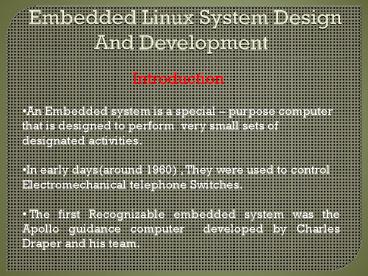Embedded Linux System Design And Development - PowerPoint PPT Presentation
1 / 13
Title:
Embedded Linux System Design And Development
Description:
The Free Standard Group (FSG) released Linux. Standard Base (LSB) specifications. ... Runtime Royalty. Why Embedded Linux? ( cont.) Open Source. POSIX Compliant ... – PowerPoint PPT presentation
Number of Views:458
Avg rating:3.0/5.0
Title: Embedded Linux System Design And Development
1
Embedded Linux System Design And Development
- Introduction
- An Embedded system is a special purpose
computer that is designed to perform very small
sets of designated activities. - In early days(around 1960) , They were used to
control Electromechanical telephone Switches. - The first Recognizable embedded system was the
Apollo guidance computer developed by Charles
Draper and his team.
2
Embedded Linux System Design And Development
- Introduction (cot. )
- Today they are widely used to serve various
purposes - Network Equipments such as firewall, router ,
switches. - Consumer Equipment such as MP3 players , cell
phones, PDAs, digital. - Household appliances such as microwaves , washing
machines, televisions . - Mission-Critical systems such as satellites and
flight controls.
3
- Key factors that differentiate an embedded system
from the desktop computer - Embedded systems are usually cost sensitive.
- Most Embedded Systems have real time constraints.
- There are multitude CPU architectures that are
used in embedded systems. - Embedded systems employ application-specific
processors. For example , the processor in our
digital camera is specially tailored for image
capturing and rendering.
4
- Key factors that differentiate an embedded system
from the desktop computer (cont.) - Embedded systems have very few resources in terms
of RAM , Rom or other I/O devices as compared to
a desktop computer. - Power management is an important aspect in most
embedded systems. - Embedded systems generally have an inbuilt
circuitry for debugging purposes. - An Embedded System is designed from both the
hardware and software - perspective, taken into account a specific
application or set of applications.
5
- HISTORY OF EMBEDDED LINUX
- Linus Benedict Torvalds at the University of
Helsinki - created the Linux Operating system in 1991.
- Under the GNU General Public License (GPL) ,
Linux - License is released. It has allowed all the
source code - to be freely available for personal or commercial
use.
6
- HISTORY OF EMBEDDED LINUX
- In early 1996, Michael Barabanov and Victor
Yodaiken - used Linux in real-time embedded systems as a
- research project. This RT-Linux research project
was - based on using a small real-time kernel along
with - Linux to provide real time deadline guarantees.
- Year 1999
- Linux started to develop its roots in Embedded
- Systems Area.
- Year 2000
- Many companies adopted Embedded Linux in their
- Product lines.
7
HISTORY OF EMBEDDED LINUX (cont.) Year
2001 Release of Linux Kernel 2.4, which was later
adopted in many Embedded Linux Distributions.
Embedded Linux standardization efforts started
gaining ground. The Free Standard Group (FSG)
released Linux Standard Base (LSB)
specifications. In terms of tools and utilities
uClibc was made. uClibc now is an integral part
of almost all Embedded Linux distributions.
8
HISTORY OF EMBEDDED LINUX (cont.) Year
2002 Release of Linux Kernel 2.4, which was later
adopted in many Embedded Linux Distributions.
Embedded Linux standardization efforts started
gaining ground. The Free Standard Group (FSG)
released Linux Standard Base (LSB)
specifications. In terms of tools and utilities
uClibc was made. uClibc now is an integral part
of almost all Embedded Linux distributions.
9
HISTORY OF EMBEDDED LINUX (cont.) Year
2003 Linux saw its growth in the Cell phone and
Digital Entertainment Industry. Linux saw more
penetration in gateways, routers and wireless
LANs. Year 2004 Free Standard Group (FSG) and
Open Source Development Lab (OSDL) released
Linux Standard Base LSB 2.0
10
- HISTORY OF EMBEDDED LINUX (cont.)
- Thus lots of companies are adopting Embedded
- Linux for their new designs.
- Various Vendors are providing Embedded
- Linux Distribution for various Hardware
platforms. - Silicon suppliers use Linux as a preferred
- hardware bring-up platform
11
- Why Embedded Linux?
- Vendor Independence
- Time to Market
- Varied hardware Support
- Low Cost
- Development Cost
- Training and Hiring Cost
- Runtime Royalty
12
- Why Embedded Linux? (cont.)
- Open Source
- POSIX Compliant APIs
13
The End































